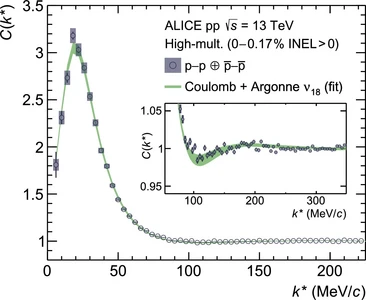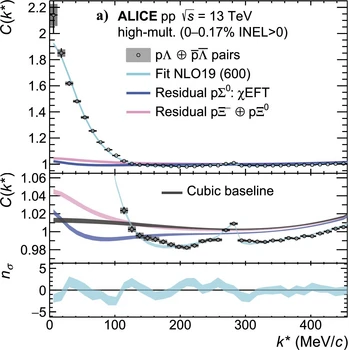The hyperon puzzle in neutron stars: studying the two- and three-body strong forces between strange baryons and nucleons at ALICE
Neutron stars are one of the most compact objects in our universe: imagine a sphere with a radius of roughly 12-14 km encasing more or less a mass that can be more than 2 times the mass of our Sun. Based on these numbers that have been obtained from astrophysical measurements, we can already understand that inside the core of this astrophysical objects, densities much larger than the nuclear saturation density of nuclei can be reached. The question then is: which kind of matter should we expect in such a dense environment? Normal nucleons or maybe also more “exotic” particles? One possible scenario that can occur is that, due to the large density, strange baryons should be favoured to be produced. These strange baryons are called hyperons. But once these hyperons are produced, it is basically impossible to build, from a theoretical point of view, a neutron star with the heavy observed masses. This is the hyperon puzzle.
To really be sure if this is indeed a puzzle, in our group we aim at understanding how these hyperons interact with the nucleons at finite density.
To do so, we need to first address the study of hyperon-nucleon and hyperon-nucleon-nucleon interactions in the vacuum. Indeed, already this basic piece of information is very poorly known. Scattering data with low statistics for the most commonly produced hyperon species, such as Λ and Σ, are available. Measurements of Λ-hypernuclei of different size deliver information about the average interaction of this hyperon with nucleons but a detailed parametrization of the interaction as a function of the hadron distance is not available. Moreover, for hyperons composed of more than one strange quark, such as Ξ and Ω, we basically do not have any quantitative information on their interaction with protons and neutrons.
This is where the femtoscopy technique enters the game.
The femtoscopy era was started in astronomy by measuring the (angular) size of stars by investigating the correlations between photons emitted from the latter. In particle physics the method was independently established to exploit the production of pions and introduce a symmetrization of the multiparticle wave function to describe the observed spectra. This (anti)symmetrization of the total wave function is a basic principle of quantum mechanics and influences particle pairs which are produced closely in phase-space and travels to the detector with a small relative momentum. Not only quantum statistics influences the final spectra but also final state interactions can play a role.
Femtoscopy normally focuses on the investigation of the size and time evolution of the region the particles are emitted from, which happens on the femtometer scale (10^−15 m). But since the femtoscopy signal also depends on the final state interaction, if the source is under control, we can use this method to study the strong interaction of pairs that cannot be accessed with traditional experimental approaches.
We started our journey towards a better understanding of these hyperon-nucleon interactions in 2016, by using p+p, p+A reactions at different energies (GeV at the HADES experiment and TeV at the ALICE experiment). The measurements of p-p pairs have been used within our group to build a data-driven model for the emitting source. An example of a measured p-p correlation with ALICE is shown in the figure on the left.
We moved then to measure at pairs composed of a hyperon and a nucleon.
The analysis on the p-Λ correlation function shown on the right was performed within our ALICE group and delivered the most precise measurements of the scattering parameters for this interaction. You can already see that the correlation function for p-p and p-Λ looks different. The reason is that a proton interacts differently with another proton or a Λ.
The power of the correlation function is that its behavior as a function of the relative momentum k* can tell us about the underlying interaction of the pair we are measuring. An attractive interaction manifests itself as a correlation function larger than 1, while a negative interaction leads to values lower than 1. One can see this in the effect of the attractive long-range p-p and Λ-p interaction and in the Coulomb repulsion for p-p. These plots show that the method works.
The LHC Run 2 data-taking period, from 2016 to 2018, gave us the opportunity to also measure even more “strange” pairs, such as p-Ξ, and to extend the femtoscopy method to triplets. With the measurements of three-particle correlations, p-p-p and p-p-Λ, we are attempting to address the extremely challenging open problem of the many-body dynamics which is crucial for the hyperon puzzle. The data collected so far are not enough to draw quantitative conclusions on the interaction yet but we are already working on Run 3 data and for future upgrades on the ALICE detector that will improve our precision (see ALICE 3 and ITS3).
In 2025, we harvested our correlation measurements campaign at ALICE with many hyperon-nucleon pairs, from p-Λ to p-Ξ and even Λ-Λ.
By collaborating with some of our theory colleagues, we now have a first model for a neutron star composed of Λ,Σ and Ξ hyperons interacting with the surrounding nucleons. These results, shown in the figure, consider only two-body interaction and our stable star configuration reaches at maximum 1.4 solar masses. But we know that there is still a physics ingredient missing: the three-body hyperon-nucleon-nucleon interactions!! We are working hard to improve our understanding on these using multi-particle correlations and extending it also to Σ and Ξ hyperons.
Further reading:
- The Femto Bible (aka PhD Thesis of Dr. D. Mihaylov)
- Paper on the p-Λ correlation function
- Paper on Neutron Star Properties and Femtoscopic Constraints


